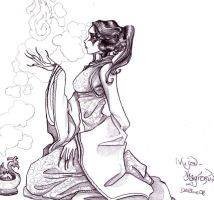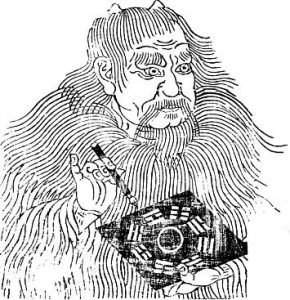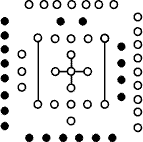Shamanic Origins Of Medicine In Ancient China

The link between medicine and shamanism in ancient China can be found in the etymology of the words used to describe the practices, as well as other ancient texts.
This story is an expansion from an original piece published on Facebook and Steemit, in October 2017
I recently came across an interesting anthropological and linguistic fact that I hadn't come across before, courtesy of this fantastic article.
I've been teaching the history & philosophy of Chinese Medicine at a local TCM institute for several years now, so I read a lot about this sort of thing.
The Chinese character for 'doctor', 'medicine', 'cure' – Yī – changed sometime during the Han Dynasty (206BCE - 220CE) to become:
醫
It is made up of three radicals (parts), and the top-left radical is now the simplified version used in modern Chinese. It's the lower radical that is of interest in this discussion:
This is the radical for 'wine' – yŏu – it's not a word in its own right, but is added to other words to help with either the phonetic or the idea/meaning of the word. It is thought that perhaps the addition of the 'wine' radical was due to the fact that physicians during the Han Dynasty began to utilise herbs steeped in alcohol (rice wine) as their major form of Medicine.
Prior to this period, the character for a doctor was:
The lower radical instead is the character for shaman – wū – 巫.
It suggests that prior to the Unification in the 2nd Century BCE, medicine and healing was related to the shamanic tradition.
We have evidence of the roles of these wū-shamans going back as far as the Shang Dynasty (~1600 —1046 BCE). They were at various times involved with rain-making and consulted as diviners, seers, soothsayers, and also for healing. From the textual evidence we currently have, there is no evidence that they were prescribing medicines or performing therapeutic treatments other than conducting healing rituals and appeasing ancestor-spirits to heal illness.
Etymology of 巫
The etymology of wū is interesting in its own right.

Development of the character wu over time.
It comprises of the radical gōng 工 (as in 'Qigong') meaning 'work' or 'mastery'. Within which we find two iterations of the radical for 'human' rén 人.
The wū-shamans were said to have a 'double body'. This is common amongst shamanistic traditions around the world... so interesting the double representation of the rén radical. The idea of the 'double body' was that a shaman could be in two places at once - the real, temporal world, but also the timeless, spiritual world. In modern understanding, we could surmise that they were able to enter into altered states at will and access their Unconscious Mind in order to access information otherwise hidden from the Conscious Mind.
However, combined with gōng implies the wu-shaman worked at mastering some kind of communion with spirits (ancestors), and interceding and mediating between the living and the dead to achieve specific outcomes of individual and social wellness. That this was an artisanal endeavour, something akin to bronze-casting, metal-smithing, painting, or pottery.
Why is it interesting?
For me it suggests that the origins of medicine in China are very clearly derived from shamanic roots, and that many of the fundamental ideas and frameworks which were compiled into the Han Dynasty foundational text Huáng Dì Nèi Jīng – the Yellow Emperor's Inner Classic [of Medicine] – stem from the shamanic world-view of ancient doctors.
It also suggests to me a significant epistemological shift at that time to a more systematised form of medicine, incorporating the prescriptions of [herbal] medicines and the use of Acupuncture, Moxibustion, and Physiotherapies.
Fù Xī and the development of the I Ching

Fù Xī, mythical civilisation hero of ancient China
I believe we also have one important extant piece of evidence that points to ancient Chinese philosophy's shamanic roots - the inimitable I Ching Book of Changes, said to have originally written by one the legendary ancient culture-heroes, Fù Xī.

The 'River Diagram' said to have been created by Fù Xī
As the legend goes, he was sitting by a river one day when an "uncanny turtle" appeared out of the waters, and on its back was a diagram called the Hé-tú – river diagram – from which Fù Xī was able to come up with the original sequence of the 64 Hexagrams.
During the Shang Dynasty, turtle carapaces, as well as oxen scapulae, were used as divining tools. Fù Xī's legend may be linked to the memory of this early form of divination, thus linking the I Ching with the Oracle Bones texts, and with shamanic rituals and systems of practice.
Confucius himself mentions the wū-shamans in his book The Analects (13:22, my translation):
Here he is linking shamans and doctors to the I Ching's 32nd Hexagram 恆 héng, which concerns itself with the development of perseverance as necessary quality. This trait allows the 'superior person' to stay on our path, and remain unaffected by external factors that seek to distract us from our intentions. The point Confucius was said to be making in this verse is that there is no point in consulting the oracle to find the answer to why he's not achieving his outcomes if he doesn't have perseverance and is constantly straying from his path.人而無恆,rén ér wúhéng 不可以作巫醫。bù kě yǐ zuò wū yī "A person without perseverance cannot be regarded as a shaman or a doctor."
He was a big supporter in the ancient Zhou rituals, seeing them as playing an important social function, as well as creating a type of 'language of behaviour'. The placement of the I Ching as one of only 5 canonical texts emphasises the role that divination (占 zhān, originally a function of the wū-shaman) also played in maintaining a harmonious society.
Observing patterns
The verb 占 zhān is 'to practice divination'; to divine is also 'to observe'. Divination in ancient China was more about observing patterns in nature, and being able to develop predictive models based on the observations of those patterns.
In modern Western Medicine, the focus is on 'diagnosis'. This word, originally from the Greek, means to distinguish one thing from another, or to know something apart from another. The implication that a separation is created in what is understood between 'that which is right' and 'that which is wrong'.
This is not the process a Chinese Medicine practitioner takes when determine what is wrong with a patient, who instead observes the pattern formed by the presence of all signs and symptoms, both objective and subjective. TCM descriptions of pathologies are more akin to what we nowadays understand as 'syndromes'.
It appears that without any firm evidence of the shamanic roots of Chinese Medicine, we could at least speculate that this may be the case, by examining the etymology of the glyphs and words used to discuss these concepts.
Your thoughts?
Please feel free to leave a comment if you have anything interesting or different to add to the discussion.

Posted from my blog PANDORA'S LOST GIFT with SteemPress : http://metametheus.net/shamanic-origins-of-medicine-in-ancient-china/
It makes so much sense! 💚
Yeah, it was a bit of an a-hah! moment when I saw the etymology of the words. A bit more research rounded the picture out for me. 🙏🏽
Woo! Love your post - we've given you a wee upvote and hope it helps you continue to write such amazing posts.
If you're a supporter of all things natural healing, and haven't already got on board our collective, you might like to read our introductory post here. We'd also love to welcome you on Discord here!!
Resteeming this. It's really fascinating! I love how the history can be found in the language and the mythology.
Thanks. Will do. 🙏🏽
Posted using Partiko iOS
And dont' forget to drop this in the post promotion channel lovely - it's truly worthy! x
Congratulations! This post has been upvoted from the communal account, @minnowsupport, by Petah Raven from the Minnow Support Project. It's a witness project run by aggroed, ausbitbank, teamsteem, someguy123, neoxian, followbtcnews, and netuoso. The goal is to help Steemit grow by supporting Minnows. Please find us at the Peace, Abundance, and Liberty Network (PALnet) Discord Channel. It's a completely public and open space to all members of the Steemit community who voluntarily choose to be there.
If you would like to delegate to the Minnow Support Project you can do so by clicking on the following links: 50SP, 100SP, 250SP, 500SP, 1000SP, 5000SP.
Be sure to leave at least 50SP undelegated on your account.
As a follower of @followforupvotes this post has been randomly selected and upvoted! Enjoy your upvote and have a great day!
Congratulations @metametheus! You have completed the following achievement on Steemit and have been rewarded with new badge(s) :
Click on the badge to view your Board of Honor.
If you no longer want to receive notifications, reply to this comment with the word
STOPDo not miss the last post from @steemitboard:
SteemitBoard and the Veterans on Steemit - The First Community Badge.
This post was shared in the Curation Collective Discord community for curators, and upvoted and resteemed by the @c-squared community account after manual review.
Etymology can teach us soooo much!! I simply love this. Here in Thailand the shamanic roots are still very much a "thing". We have regular doctors "Mor", we have massage doctors "Mor Nuad" and then we have "Mor Duu" - the seeing-shamanic Doctors. Still very much acknowledged as healers. Appreciating your insights. :)